Canon EOS 600D / Rebel T3i
-
-
Written by Gordon Laing
Verdict
NEW: Canon T3i / 600D vs Nikon D5100 review
Canon’s EOS 600D / Rebel T3i is the company’s latest upper entry-level DSLR, which at first glance appears to be little more than the EOS 550D / T2i equipped with a flip-out screen and wireless flash control. After all, both cameras are roughly the same size, shape and weight, and share the same 18 Megapixel sensor, core HD movie modes, viewfinder, 9-point AF system, 3.7fps continuous shooting, 3in 1040k screen and 63-zone metering system.
There’s also a great deal of overlap with the higher-end EOS 60D, which meant the new model was greeted by many with a shrug. But what Canon’s doing here is following a simple strategy that’s proven successful for companies like Sony: to offer a wide variety of products with often only subtle differences to target every buyer. There will be those who are already completely satisfied with the 550D / T2i, but others who looked enviously at the 60D’s flip-out screen and or wireless flash control. Now they can have those in a smaller, lighter and cheaper body than the 60D. Then there’s those who like the photo and movie quality of the 550D / T2i but want a better viewfinder, superior AF and faster continuous shooting, and for them, the EOS 60D is the sensible choice. And so on as you scale-up the range. Canon’s simply filling every gap.
But while this strategy alone may justify creating in-betweener models, the EOS 600D / T3i is actually more than an EOS 550D / T2i with an articulated screen and wireless flash control. It inherits a number of small but useful features from the EOS 60D, including manual control over audio levels in movies, creative effects in playback and multiple aspect ratios in Live View. The new camera is not all about inheritance either, as it introduces scene detection in Auto along with Digital Zoom and Video Snapshot movie options; the latter sound like novelties, but as we discovered they can deliver highly compelling results to certain movie makers.
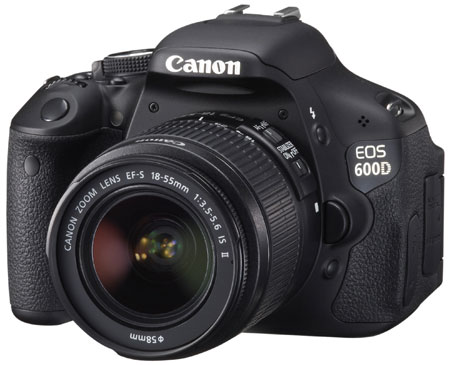 | |
Starting with the image and movie quality, there’s understandably no surprises here. With the same sensor and core movie modes as the EOS 550D / T2i, EOS 60D and EOS 7D before it, we’re already familiar with the resolution, noise and video performance of the Canon 18 Megapixel CMOS sensor. As such, the EOS 600D / T3i delivers good-looking high resolution images with a sensible balance between noise reduction and detail retention, although you won’t see any advantage over 14-16 Megapixel models unless you equip it with something superior to the EF-S 18-55mm IS II kit lens.
Handling is also familiar as it’s essentially the same as the EOS 550D / T2i before it. Both are relatively compact and light bodies, although we preferred the coarser texture of the rubber grip surfaces on the new model. The AF system remains 9-point with only one cross-type sensor in the middle, and continuous shooting is still fixed at 3.7fps, although JPEGs are now limited to smaller bursts than before. Despite slightly different quoted specifications we believe the viewfinders are identical. These specifications are fine for day-to-day photography, although action shooters will find the focusing and continuous shooting too leisurely for anything other than casual snaps. It’s the same old Canon story: if you want tougher build or snappier performance, you’ll need to move into its mid-range or semi-pro category. Anyone who wants faster shooting at this lower price point is better served by Sony.
So far so similar, so what about the differences? The most obvious benefit of the EOS 600D / T3i over the 550D / T2i is its articulated display, inherited from the EOS 60D. This allows the screen to twist and flip in any direction, for easy composition at high or low angles, along with folding out to face the photographer or back on itself for protection. As you’d expect it transforms the movie-making experience into something much closer to using a camcorder, but it will equally be appreciated by specialist still photographers operating in Live View. Product, macro and astro photographers frequently find their cameras in awkward positions, but with the EOS 600D / T3i they can simply twist the screen to a more convenient angle. It’s also useful for discreet or candid photography.
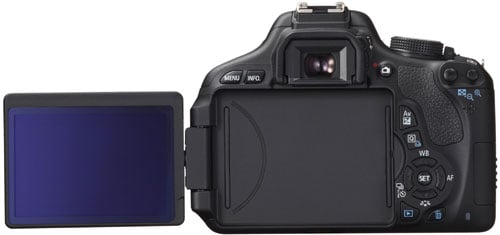 |
We should also mention while this is the third Canon DSLR to feature the company’s 3in 1040k pixel screen, the panel remains superb in use. The 3:2 aspect ratio means photos fill the screen, while 16:9 content is bounded by thin bars. There’s a massive amount of detail which not only looks great during playback, but also helps when focusing in the movie mode. It’s the best of the DSLR screens at the time of writing.
Moving on, the next major update is wireless flash control. The built-in flash can be used as a Master to wirelessly trigger compatible Speedlites, although the implementation is a little simpler and more consumer-friendly than the EOS 60D and EOS 7D. While there’s still a Custom option for enthusiasts who like to get their hands dirty, a new Easy option allows beginners to enjoy the benefits of multiple flash setups with the minimum of fuss. Great for portraits or action shots.
In the nice-to-have but hardly-critical camp are the multiple aspect ratios in Live View, Creative Filter effects in playback and the enhanced Auto mode with scene detection. Much more important in our view are the new Digital Zoom and Video Snapshot modes. Both sound like novelties, but don’t discount them.
The term Digital Zoom may be rightly treated with derision by enthusiasts, but the EOS 600D / T3i uses a combination of cropping and scaling to deliver its 3-10x range in the 1080p movie mode. Crucially at the start of the range, the ‘3x’ setting appears to employ a crop alone, thereby delivering a magnified view with no loss in quality. In our tests the magnification was closer to 2.5x, but again the 1:1 pixel crop from the middle of the sensor means fans of long telephotos can get even closer to their subjects without compromising video quality. Forget digital processing and instead think of it as a 2.5x tele-converter for video. Whether you’re filming sports, wildlife or the Moon, this is a valuable extension to the range of your lenses and for some specialist videographers may justify the 600D / T3i over any other model in the current Canon line-up. Beyond ‘3x’, the camera employs scaling with ever decreasing quality, but it can still be a fun result. See our Movie Mode page for a full report.
The new Video Snapshot mode will appeal to a completely different audience. It captures very short clips, lasting two, four or eight seconds, and automatically stores them as a single movie file. This allows you to quickly and easily assemble a short film without any editing software, which could be ideal for providing an overview of real-estate or tourist attractions. It’s also simply great fun for aspiring film makers, not to mention their viewers who aren’t subjected to long takes.
Combine these two modes with an articulated screen, manual control over exposures, a microphone input and adjustment of audio levels (new over the 550D / T2i), and you’ve arguably got the most confident Canon DSLR for recording movies. Sadly there’s still no continuous AF while filming, but if you’re happy to manually focus or film subjects which don’t move outside your chosen depth of field, you’ll enjoy superb results. If you want a camera with a big sensor and removable lenses which can continuously autofocus while filming, you’ll need to go for a hybrid model like Sony’s Alpha SLT-A33 / A55 or Panasonic’s Lumix GH2.
With that said, let’s see how the EOS 600D / T3i compares against some key rivals.
Compared to Canon EOS 550D / Rebel T2i
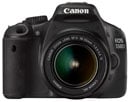 | ||
The EOS 550D / T2i is the closest model to the EOS 600D / T3i. Both cameras are roughly the same size, shape and weight, and share the same 18 Megapixel sensor, core HD movie modes, penta-mirror viewfinder, 9-point AF system, 3.7fps continuous shooting, 3in 1040k screen and 63-zone metering system. As such the core handling and quality of both cameras is identical.
In its favour, the EOS 600D / T3i features a fully articulated screen which allows easy Live View composition or filming at unusual angles, wireless flash control over multiple Speedlites for creative portrait and action lighting, manual control over audio levels for movies, a Digital Zoom facility which magnifies 1080p footage by 3-10x, a Video Snapshot mode which compiles multiple short video clips into a single movie file, multiple aspect ratios in Live View, five Creative Filters which can be applied during playback, tweaked scene presets and an enhanced Auto+ mode which employs scene detection.
Most of the key improvements are in the movie mode, so if you’re mostly into taking still photos and tend to compose with the viewfinder alone, then there’s not much advantage to the 600D / T3i over the earlier model. Advanced portrait or action shooters will appreciate the addition of wireless flash control, but if you can live without it and the movie enhancements, then the 550D / T2i is a more sensible choice. It’ll deliver the same core photo and video quality at a lower price point, leaving you more money to spend on extras like lenses.
See our Canon EOS 550D / T2i review for more details.
Compared to Canon EOS 60D
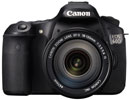 | ||
Canon’s EOS 60D is the next model up from the EOS 600D / T3i. Like the EOS 550D / T2i, there are a number of key similarities with the EOS 600D / T3i, including the same 18 Megapixel sensor, core movie modes, 3in 1040k screen and 63-zone metering system. As such the image and video quality of all three cameras are identical. The EOS 60D and EOS 600D / T3i also share the same articulated screen mounting, manual control over audio levels in movies and multiple aspect ratios in Live View, along with similar wireless flash control and creative filters in playback.
The EOS 60D does however enjoy a number of key benefits over the EOS 600D / T3i. It features a larger, brighter penta-prism viewfinder (0.95x vs 0.87x), faster continuous shooting (5.3 vs 3.7fps), a more sensitive AF system (where all nine points are cross-type rather than just the one in the middle), an upper information screen, in-camera processing of RAW files, a second control wheel, a virtual horizon indicator, faster maximum shutter speed and flash-sync speed, and a battery which gives accurate feedback on life remaining. The body materials may be the same, but the EOS 60D feels much better in your hands and much more like a semi-pro body, albeit without the ultimate toughness of magnesium alloy.
It’s not all one-sided though: the EOS 600D / T3i is smaller, lighter and cheaper, features Digital Zoom and Video Snapshot movie options, and also sports a custom self-timer and an additional Creative Filter in playback. The Auto mode is enhanced with scene detection and while the wireless flash options aren’t as sophisticated as the EOS 60D, there is an Easy mode for beginners. Some may also prefer the smaller size and lighter weight of the 600D / T3i, especially if you’re hiking with the camera or balancing it on a telescope.
Ultimately if you’re happy with the build, speed and handling of the EOS 550D / T2i but want the flip-out screen or wireless flash control, then the EOS 600D / T3i now gives you them in a smaller, lighter and cheaper package than the EOS 60D. But be in no doubt, the EOS 60D is a more sophisticated DSLR, particularly in terms of speed and handling. If you need snappier AF and faster continuous shooting, value a bigger brighter viewfinder and prefer a chunkier body then it’s worth spending the extra for the EOS 60D, or even stepping-up further to the truly semi-professional EOS 7D.
See our Canon EOS 60D review for more details.
Compared to Sony Alpha SLT-A55
| ” –> |
|---|
 | ||
For much the same price as the EOS 600D / T3i, you could alternatively buy the Sony Alpha SLT-A55. Both capture high resolution stills and HD video, and feature flip-out 3in / 1040k screens, but the A55 is a significantly different camera and one which may be more appropriate to your requirements, especially if you’re into fast action or continuous AF during movies.
The SLT-A55 may look like a traditional DSLR from the outside, but employs a fixed semi-reflective mirror and a full-time Live View system with composition on-screen or through an electronic viewfinder. The semi-reflective mirror directs some light to a phase change AF sensor, which gives the A55 a unique combination of Live View composition or movie filming with fast and continuous autofocus – something a traditional DSLR like the EOS 600D / T3i can only dream of.
So that’s the first major benefit of the SLT-A55 over the EOS 600D / T3i: continuous autofocus while filming HD video, and while you’ll hear the standard Sony kit lens focusing on your recordings, it remains an impressive feat and one that’s close to a camcorder experience. Likewise the SLT-A55 enjoys the same continuous autofocus capabilities for normal photo composition, so you could capture moving action in Live View, again something which eludes traditional DSLRs which only offer fast continuous AF tracking through their optical viewfinders.
The other key benefit of the SLT-A55 is fast continuous shooting. The EOS 600D / T3i is stuck at a paltry 3.7fps, whereas the A55 boasts a whopping 10fps. The A55 also features a denser 15-point AF system, built-in GPS receiver for tagging your images with location details, along with a viewfinder which may be electronic, but sports a much bigger apparent image size than the relatively small viewfinder on the Canon, along with super-imposed graphics including a dual-axis level gauge.
In terms of still photo quality, the SLT-A55 may fall short of the EOS 600D / T3i by 2 Megapixels, but both cameras resolve roughly the same amount of detail when equipped with their standard kit lenses. And while the semi-reflective mirror in the A55 may permanently lose some of the incoming light to the phase-change AF sensor, it makes up for it with a Multi-frame Noise Reduction mode which combines six frames taken in quick succession into a single image. The SLT-A55 is also smaller, which might give you less to grab onto, but will be welcomed by anyone tight on bag space.
Again it’s not all one-sided though. The traditional DSLR design of the EOS 600D / T3i means you’ll see a ‘live’ image between frames in a continuous burst allowing you to recompose for moving subjects; the A55 can do this, but only when shooting at 2.5fps, otherwise you’re shooting fairly blind with replayed images rather than a live view between frames. Many traditional photographers will also prefer looking through the EOS 600D / T3i’s optical viewfinder, which may be smaller than the A55’s electronic finder, but delivers a real view with finer detail, broader tonal range and no noise gain in low light.
The A55 may boast continuous AF while filming, but the EOS 600D / T3i features more movie options, including 1080p and 720p at different frame rates, manual control over recording levels and the Digital Zoom and Video Snapshot modes. We also much preferred the Canon screen being hinged at the side rather than at the bottom on the Sony.
There’s a lot to weigh-up here, but if you want continuous focusing while filming and fast continuous shooting, and don’t mind electronic composition, then the SLT-A55 is hard to beat. We hope to review the SLT-A55 in the future, but the cheaper A33 is very similar, so for more details, please check out our Sony Alpha SLT-A33 review.
Compared to Nikon D5100
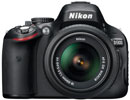 | ||
The biggest rival to the EOS 600D / T3i is undoubtedly the Nikon D5100. Both models were announced within two months of each other, share similar core capabilities including 1080p movies, articulated high resolution screens and microphone inputs, along with being roughly the same size, weight and price. To see the differences, you need to look closely at the specifications.
In its favour, the D5100 sports an 11-point AF system to the Canon’s nine, fractionally quicker continuous shooting of 4fps compared to 3.7fps, continuous AF while filming videos (albeit nothing like you’d get with a camcorder or a Sony SLT), a selection of special effects which can be applied while shooting or filming, a dedicated record button to start filming at any time, a maximum sensitivity of 25,600 ISO (along with a Night Vision mode at 102,400 ISO), in-camera HDR (albeit with only two frames), front and rear IR ports for an optional remote control (the Canon only has a front sensor), a built-in Intervalometer for automatic shooting, and a user interface that’s arguably better for beginners.
In its favour, the EOS 600D / T3i has wireless flash control, a slightly wider screen which matches the native shape of its images (avoiding letterboxing in playback or Live View), full manual control over exposures in the movie mode, digital zoom and video snapshot movie options, 720p movies at higher frame rates of 50 or 60fps (versus 24, 25 and 30fps), audio level meters and fine control over adjustments, a live histogram in Live View, direct access to ISO, White Balance, AF modes and more along with a quicker user interface, and a fractionally bigger viewfinder image which additionally shows the ISO value at all times.
In terms of image quality, the EOS 600D / T3i boasts 18 megapixels to its rival’s 16, but as we saw when comparing the D7000 against the EOS 60D, this makes little difference to resolved detail, and the Nikon enjoys a quality advantage at 3200 ISO and above.
Unlike the previous generations, the Canon and Nikon mid-range DSLRs are closer than ever before and if the minor differences in features don’t sway you, a lot will boil down to personal preferences in styling and brand loyalty.
For more details, check out our Nikon D5100 review.
Canon EOS 600D / Rebel T3i final verdict
The EOS 600D / Rebel T3i continues a strategy started with the EOS 60D, where Canon slots a new camera in-between existing ones, rather than directly replacing a specific model. As such the EOS 600D / T3i slots between the EOS 550D / Rebel T2i and the EOS 60D, narrowing their feature gap.
While frustrating for people who desire greater innovation, it’s important to note it’s a strategy that’s worked well for companies like Sony, effectively offering multiple products with similar feature-sets, but with key up-selling advantages to each. Many people want the articulated screen or wireless flash control of the 60D, but prefer the lower price and form factor of the 550D / T2i. Now rather than potentially lose sales to a rival, the EOS 600D / T3i provides these features in a smaller, lighter and cheaper package than the 60D.
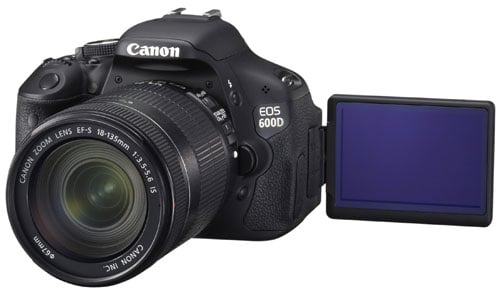 |
At first glance, the EOS 600D / T3i could simply be described as either a 550D / T2i with a flip-out-screen and wireless flash control, or a smaller, lighter and cheaper, but slower version of the 60D. But look closer and this assessment would be doing the latest EOS DSLR a disservice, as there’s more differences between the three models than first appears.
We’ve detailed them all above, but most notably the EOS 600D / T3i enjoys new Digital Zoom and Video Snapshot movie options which deliver greater functionality and better results than you may first think; indeed if you’re into filming distant or small subjects, the Digital Zoom could swing it for you over both the 550D / T2i and 60D. These new modes combined with the articulated screen and manual audio levels deliver a considerably more sophisticated video experience than the 550D / T2i.
Still-photographers will however find less reason to go for the 600D / T3i over the models on either side. Unless you really want wireless flash control or love shooting in Live View at unusual angles, there’s little benefit for still photography over the 550D / T2i. Likewise if you want tougher build, better ergonomics, a bigger viewfinder, quicker AF or faster continuous shooting from a Canon, you’ll need to skip the EOS 600D / T3i and head up to the EOS 60D or further still to the EOS 7D.
But once again if you’re into shooting video, the EOS 600D /T3i delivers arguably the best experience of any Canon DSLR to date – an impressive feat, considering it’s one of the cheapest models too. There may still be no continuous AF while filming, but everything else, from composition and control to effects and editing works very well, and specialist videographers may find the Digital Zoom or Video Snapshot justify the purchase over anything else.
Some may be frustrated the 600D / T3i’s new features are concentrated around video rather than stills, but that continues to be Canon’s strategy at the entry-level end of the market. It’s allowed Sony to grab market share with fast continuous shooting from low cost bodies, but it seems unlikely Canon will change.
It’s also important to remember while the 600D / T3i doesn’t offer much innovation over its predecessor for traditional shooters, it still delivers excellent picture quality in a solid, compact and affordable body. Sure, if you’re not bothered about the articulated screen and wireless flash control, then it’s worth looking out for a 550D / T2i at a cheaper price. Conversely if you desire greater speed and can find a discounted EOS 60D, it’ll be a more sensible choice. But for those who simply want a good, solid upper-entry-level DSLR with great image quality and advanced movie features, the 600D / T3i is hard to beat. It earns our Highly Recommended rating, but consider your requirements carefully as the models on either side of it, or indeed ones from rivals may be more appropriate for your needs.
PS – for more help comparing the Canon against its Nikon rival, see our Canon T3i / 600D vs Nikon D5100 video.





